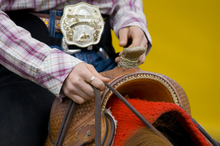When it comes to rein tension during contact, “How does the horseback rider know what they are doing? Are they doing what they think they are doing, or are they doing something completely different?” asked Dr Hayley Randle, study presenter and ISES President.

Reining tension in riding horses - Actual and perceived
Researchers from Duchy College in the UK set out to find out what differences existed between a rider's perceived rein tension and their actual rein tension when riding a horse.
Researchers from Duchy College in the UK set out to find out what differences there were between a rider’s perceived rein tension (PRT), and their actual rein tension (ART). Misperceptions between ART and PRT could lead to horse welfare and training issues. “If the person on the ground and the person on the horse are not on the same wavelength…you’ve actually got a barrier in the way already.” says Randle.
A total of 261 participants were gathered from two separate UK national equine events, with 89% identifying as amateurs, and 11% as professionals; within the study were one Olympic and one Paralympic rider. The majority of riders rode at least three times per week, and the main disciplines listed were leisure riding, show jumping and dressage.
A life sized horse head, nicknamed “Data Dave”, wore a bridle with cavesson noseband, a single-jointed snaffle bit, and had a Centaur Rein Tension Gauge™ placed between the bit and soft grip rubber reins. Participants were placed behind “Data Dave” to mimic the angle and position of a horse-mounted rider.
Participants were asked to rate their PRT on a scale of 0 (none) to 8 (maximum) for both the riders right and left hands. They were then instructed to apply their usual (actual) rein tension (ART), as if they were riding on a walking horse, and an observer recorded the number of lights illuminated for each hand, which were visible only to the observer. Each participant was tested three times.
For the majority of participants, both PRT and ART were greater for the right hand than the left hand. Professional riders, men, and riders aged 18-30 had a more realistic idea of their overall ART.
Common to the majority of tested subjects, was the significant difference between PRT and ART; most participants perceived a heavier tension than they actually used. Between the disciplines, show jumpers showed the greatest discrepancy between PRT and ART, with leisure riders coming in second, and dressage riders showing the least discrepancy between PRT and ART.
As a thank you to participants, feedback was provided after testing; subjects were informed of hand dominance, if applicable, and ART. Surprising to researchers was how commonly hand dominance occurred in riders, with some riders reportedly explaining the discrepancies being due to prior injuries having an impact on their ability to be consistent in the contact on the reins.
Of some amusement to researchers was the ”I told you so” lectures regarding hand dominance given to subjects whose testing was observed by their personal riding coaches.
Studies such as this could help improve horse welfare and training, by lessening confusion in instructions given by a trainer to a rider. Randle stated “If you’re the rider, and someone is telling you to do something, how do you know that what you are actually doing is right?
And more importantly, as the trainer on the ground, how do you know that the rider actually really understands what you are telling them; are they thinking it’s actually something very different?”
About the International Society for Equitation Science
The International Society for Equitation Science (ISES) is a not-for-profit organisation that aims to facilitate research into the training of horses to enhance horse welfare and improve the horse-rider relationship. www.equitationscience.com
